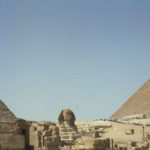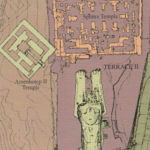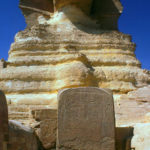Hor-em-akhet

The Sphinx and pyramids form the hieroglyph akhet
The cult of the Sphinx reached its height in New Kingdom Egypt (1550-1070 BC), when the statue was already 1,200 years old. Certain New Kingdom pharaohs came to Giza in the first year of their reigns, perhaps to be ordained by the Sphinx. They built monuments to the Sphinx or left a record of their visits.
Despite the great labor expended to create the Sphinx and its temples, there is circumstantial evidence that the cult of the Sphinx was never active in the Old Kingdom (2575-2134 BC). Among inscriptions in the hundreds of Old Kingdom tombs at Giza, there are no titles that we can recognize as a priest or priestess of the Sphinx. It appears that no one served the cult at that time.
Instead, it was the New Kingdom pharaohs who looked to the past and brought the Sphinx to life in a cult that lasted into late antiquity. By the early New Kingdom, the Egyptians already knew the Sphinx as Hor-em-akhet, “Horus in the Horizon.”
New Kingdom rebirth

Hieroglyph for horizon: akhet
Approached from the east-southeast, the Sphinx’s head appears on the horizon between the Khafre and Khufu pyramids, like the sun disk between two mountains in the hieroglyph “akhet” or horizon. The Sphinx’s head is adorned with the nemes headdress of the king who was considered the god Horus incarnate. The New Kingdom Egyptians may have given the name Hor-em-akhet to the Sphinx for this reason.
The historical origins of the Sphinx were possibly lost in the mists of time to most New Kingdom Egyptians. Hor-em-akhet must have seemed an eternal, primordial presence on the Giza Plateau.
New Kingdom structures
New Kingdom inscriptions call the Sphinx enclosure, setepet or “The Chosen.” The name may reflect a belief in the authority of Hor-em-akhet to ordain and legitimize kings when they visited in the first year of their reigns.
In the early 20th Century of our era, excavators removed many New Kingdom mud brick structures from around the Sphinx. We do not know as much as we would like to about these features because early excavators did not use modern archaeological recording techniques.
During Egypt’s golden 18th Dynasty, Amenhotep II (1425-1401 BC) built a temple to the Sphinx. In this temple, Amenhotep II paid homage to both Khufu and Khafre, builders of the two largest pyramids at Giza.
Amenhotep II’s son, Thutmose IV (1401-1390 BC), erected the famous Dream Stele between the paws of the Sphinx. The Stele tells a story of kingship promised by Hor-em-akhet to Thutmose IV for clearing the sand away from the Sphinx.
It must have been Thutmose IV who made repairs to the masonry of the Sphinx, shoring up a large boulder in the rump and encasing the body with masonry to fill in a recess eroded into the softer bedrock layers near a huge fissure that cuts across the back of the statue.
Thutmose IV also built a massive mud brick wall that encircled the Sphinx quarry like a giant cartouche. The Dream Stele of this pharaoh at the Sphinx is dated to the first year of his reign.
During the Amarna Period (1352-1338 BC), a villa was built above and in front of the nearly-buried Khafre Valley Temple.
Tutankhamun (1336-1327 BC) built a rest house on the south side of Khafre’s Valley Temple. The rest house was later reused by Ramses II.
Emerging from their rest houses near the Valley Temple, Egyptian royalty descended a stairway to a broad viewing platform built over the buried Sphinx Temple immediately in front of the Sphinx. After ritual stops at shrines and podiums, they descended farther to the heart of the cult—a small chapel between the paws of the giant statue.
After making offerings to the god, the pharaoh must have felt he was linked back to the primordial god-king, Hor-em-akhet, who towered above him.
Evidence indicates that while this reverence for the Sphinx excelled anything previously shown for the statue, New Kingdom workers were recycling stone from other monuments at Giza. They were even stripping stone from the causeway that ran from Khafre’s pyramid to his Valley Temple to use in repair of the Sphinx.
The famous Dream Stele of Thuthmose IV is a recycled lintel of a doorway from Khafre’s Pyramid Temple.
Ironically, pieces of Khafre’s own pyramid complex went into renewing a cult that may never have been active in his lifetime.


